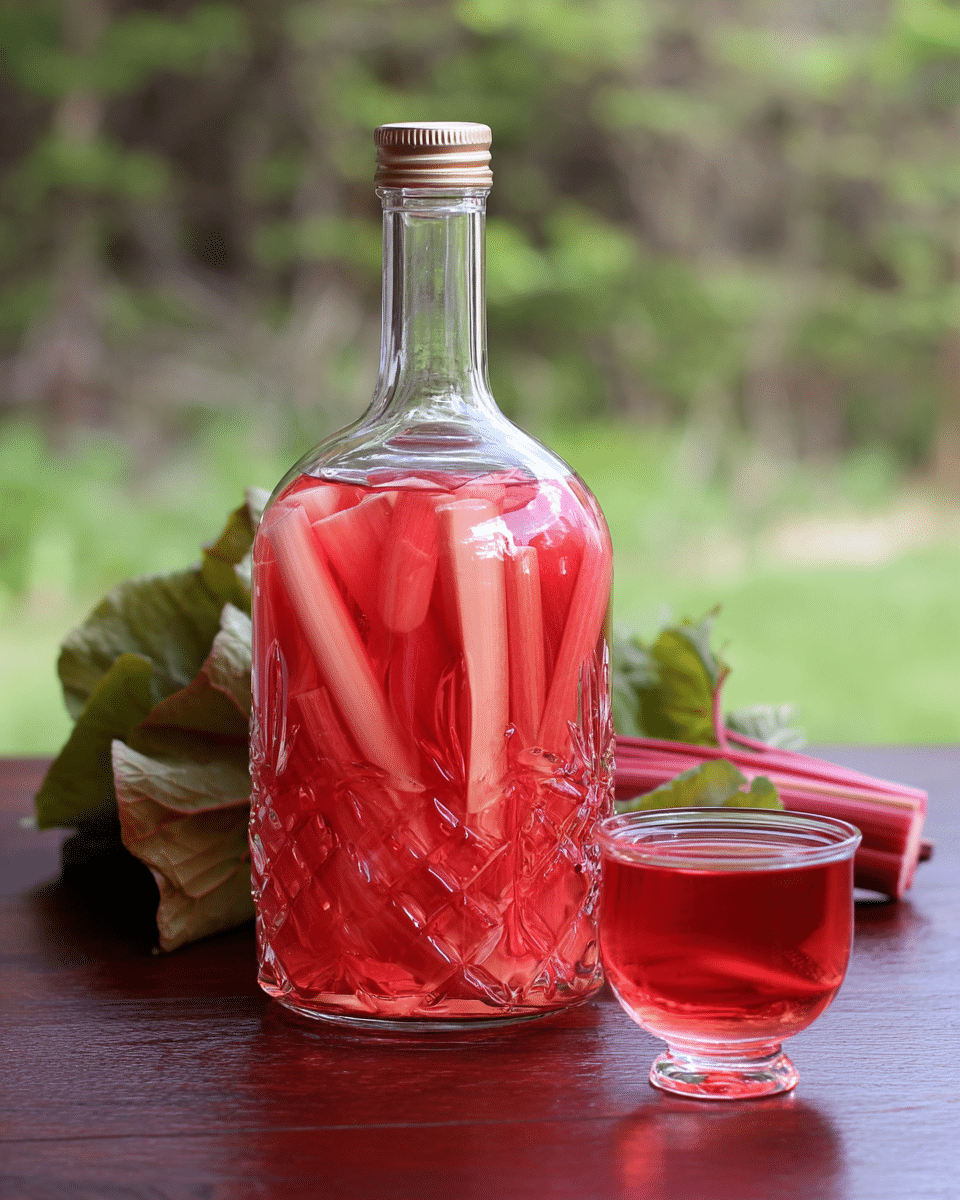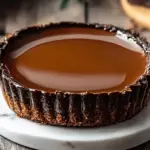The blush pink hue of this rhubarb liqueur is more than just eye candy it’s a flavor packed tribute to the fleeting magic of spring. With the tart freshness of rhubarb balanced by smooth vodka and just a kiss of sweetness, each sip is bright, bold, and utterly refreshing.
Infusing your own rhubarb liqueur is a beautiful way to preserve the harvest and add a sophisticated touch to your home bar. Whether gifted in a decorative bottle or served over ice at your next gathering, it offers a vibrant twist on traditional spirits and makes cocktail crafting just a little more magical.
Full Recipe:
Ingredients:
-
6 cups rhubarb stalks, chopped (about 1 1/2 pounds)
-
1 cup sugar (plus more to taste)
-
750 ml vodka or neutral spirit
Directions:
-
Combine the chopped rhubarb and sugar in a half-gallon mason jar or similar container. Stir well to coat the rhubarb thoroughly.
-
Let the mixture macerate at room temperature for 24 hours to draw out the color and juice from the rhubarb.
-
Pour the vodka over the macerated fruit, ensuring all the rhubarb is submerged.
-
Seal the jar tightly with a lid and place it in a cool, dark place.
-
Let the mixture infuse for 4 to 6 weeks, shaking the jar occasionally.
-
After the infusion period, strain the mixture through a fine mesh strainer to remove the solids.
-
Taste the liqueur and add additional sugar if desired. To help dissolve more sugar, use a cooled simple syrup made with equal parts sugar and water.
-
Bottle the liqueur in sterilized jars or bottles and store at room temperature out of direct sunlight.
Prep Time: 10 minutes | Infusion Time: 4–6 weeks | Total Time: 4–6 weeks
Kcal: 168 kcal per 1 oz serving | Servings: About 25 (1 oz servings)
Discovering the Charm of Rhubarb Liqueur
Few things capture the fleeting beauty of spring quite like rhubarb. With its vibrant pink stalks and tart, citrusy flavor, this humble plant signals the start of the growing season in many northern gardens. But while rhubarb often finds its way into pies, crumbles, and jams, a lesser-known and equally enchanting way to preserve its flavor is through homemade rhubarb liqueur.
Rhubarb liqueur isn’t just a delightful addition to your cocktail cabinet it’s a seasonal celebration in a bottle. Crafted with just three simple ingredients rhubarb, sugar, and vodka it embodies everything a homemade infusion should be: simple, flavorful, versatile, and beautiful.
Whether you’re a seasoned home mixologist or a beginner looking for a thoughtful DIY gift idea, rhubarb liqueur offers a unique way to preserve spring’s bounty in liquid form.
The Appeal of a Homemade Infusion
Crafting liqueurs at home is a practice as old as spirits themselves. Across Europe, especially in places like Italy, France, and Eastern Europe, fruit-based infusions are a way of life. From limoncello and cassis to elderflower schnapps and cherry brandy, infusing seasonal produce into spirits is both a preservation method and an art form.
What makes rhubarb liqueur so special is its distinct balance between sweet and tart. Rhubarb’s acidity is bold, often compared to green apples or citrus, and when macerated with sugar and steeped in alcohol, it transforms into something smooth and complex, with floral, herbaceous, and fruity undertones.
The process is also remarkably approachable. Unlike wine or mead, which require careful monitoring, yeast, and fermentation control, liqueurs are essentially steeped alcohols. Once the fruit and sugar are prepared and added to the spirit, time does most of the work.
The Science of the Infusion
Infusing vodka with rhubarb is slightly different from other fruit liqueurs. Most berries and soft fruits easily release their juices and color in alcohol, but rhubarb is unique in that it requires sugar to help extract its rich red hue. This is why maceration soaking the rhubarb in sugar before adding vodka is essential. Sugar breaks down cell walls in the rhubarb stalks, drawing out not only juice and flavor but also the signature blush-pink color that gives rhubarb liqueur its visual appeal.
Alcohol alone won’t extract color from rhubarb the way it might from raspberries or blackberries. The maceration step, even though it adds an extra 24 hours to the process, makes all the difference in both appearance and taste.
Flavor Profile and Cocktail Uses
Rhubarb liqueur is intensely aromatic and slightly tangy, with an underlying sweetness that softens its tart edges. The flavor can vary slightly depending on the variety and freshness of the rhubarb used. Some rhubarb varieties are more intensely colored and slightly sweeter, while others have a greenish hue and more acidity.
This liqueur can be served in several ways:
-
Straight over ice for a refreshing, chilled aperitif.
-
Mixed with tonic or soda water for a simple highball.
-
Paired with sparkling wine for a rhubarb spritz.
-
Shaken with gin, lemon, and egg white for a rhubarb gin fizz.
-
Used in dessert cocktails like rhubarb white Russians or rhubarb cream martinis.
Its versatility means it can replace other sweet-tart liqueurs like triple sec, limoncello, or even Campari in various cocktail formulas, adding a seasonal and homemade touch to your drinks.
Culinary Applications
Beyond the bar, rhubarb liqueur has interesting culinary uses. You can:
-
Drizzle it over vanilla ice cream or sorbet for a boozy dessert twist.
-
Add a spoonful to fruit salad or macerated strawberries for extra flavor.
-
Use it in glazes or reductions for pork, duck, or chicken.
-
Bake it into cakes or quick breads, similar to how you might use a fruit syrup or extract.
Because it retains much of rhubarb’s brightness, it plays beautifully with other springtime flavors like strawberry, mint, basil, lemon, and even elderflower.
Customizing Your Liqueur
One of the joys of making liqueur at home is the ability to customize your recipe based on personal preference. You can:
-
Adjust the sweetness: Some people prefer a less sugary liqueur, while others want a thick, syrupy dessert-style drink. The ratio of sugar can be fine-tuned during or after infusion.
-
Infuse with aromatics: Consider adding strips of lemon peel, a split vanilla bean, or even a sprig of rosemary or ginger slices during the steeping process.
-
Swap the base spirit: While vodka is the most neutral choice, you could try white rum, brandy, or gin for different undertones. Just be sure the spirit is at least 40% alcohol (80 proof) to ensure preservation and proper extraction.
This flexibility makes rhubarb liqueur a fun and creative outlet. Each batch can be slightly different, allowing you to experiment until you find your signature blend.
Shelf Life and Storage
Thanks to its high alcohol content and low moisture, rhubarb liqueur is shelf-stable for up to a year or more when stored in a cool, dark place. Over time, the color may fade slightly and the flavor may mellow, but it won’t spoil in the traditional sense.
For best results:
-
Keep it tightly sealed to prevent evaporation and contamination.
-
Store out of direct sunlight, which can degrade both flavor and color.
-
Chill before serving, especially if drinking it neat or on the rocks.
It also makes a lovely edible gift when bottled in decorative jars or swing-top bottles. Tie on a ribbon or tag with serving suggestions, and you have an elegant, handmade present suitable for birthdays, holidays, or hostess gifts.
Rhubarb and Tradition
Rhubarb has long been a staple in northern climates, especially in the UK, Scandinavia, and the northeastern U.S. and Canada. While it’s technically a vegetable, it’s treated as a fruit due to its strong acidity and tart flavor. Historically, rhubarb was used medicinally in Chinese and Arabic medicine as early as 2700 BCE, primarily for its purgative effects.
Its culinary popularity blossomed in the 18th and 19th centuries when sugar became more accessible. Paired with sweetness, rhubarb found a natural home in jams, pies, and later, spirits.
The idea of using it in liqueur is likely a modern twist on traditional fruit preservation. It marries the old with the new, embracing sustainability, zero-waste practices, and seasonal eating all in one bottle.
Conclusion:
Making rhubarb liqueur is more than just a kitchen experiment it’s a celebration of seasonality, creativity, and simplicity. In a world dominated by store-bought everything, a jar of homemade liqueur on the shelf feels like a quiet act of rebellion and joy. It reminds us that flavor doesn’t have to be complicated to be beautiful.
With its vibrant color, unmistakable tartness, and smooth finish, rhubarb liqueur is a stunning example of what you can do with just a few ingredients and a bit of patience. Whether you’re preserving your garden’s bounty, making thoughtful gifts, or elevating your cocktail game, this infusion is a ritual worth repeating each spring.
So the next time rhubarb is in season, gather a few stalks, a bottle of vodka, and some sugar and start your own tradition of crafting a spring spirit that lasts all year long.






